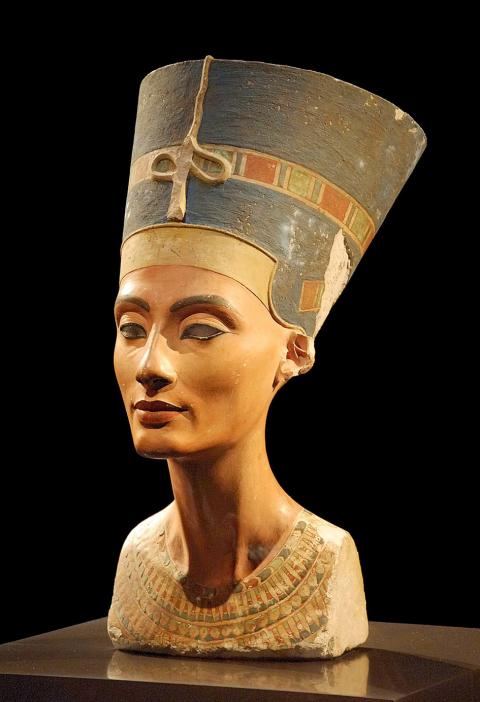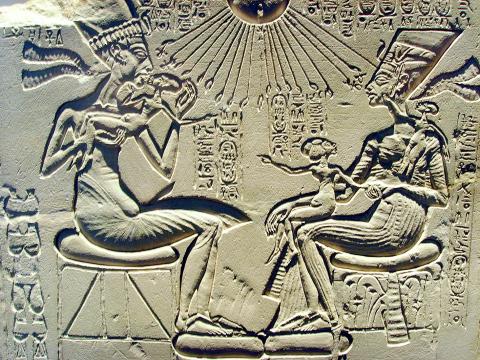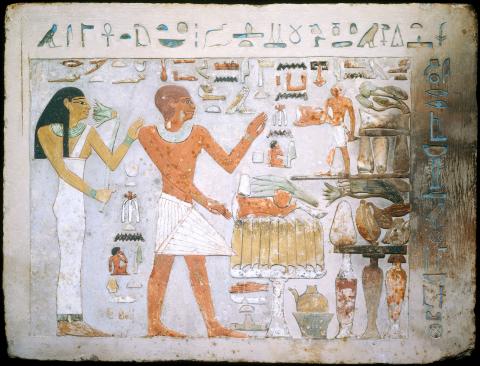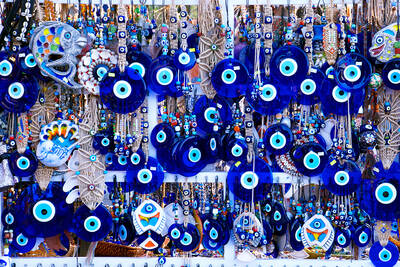The bust of Nefertiti (photo 1) is perhaps one of the most well-known of all Ancient Egyptian works of art. The realistic rendering and unique presence of the statue are worlds apart from the stiff, solemn sobriety of the majority of Egyptian art.
Nefertiti was the queen of Pharaoh Akhenaten, who reigned between 1351BC and 1334BC in the 18th dynasty of the New Kingdom period of Ancient Egypt. Akhenaten’s greatest legacy was the religious reforms he oversaw, replacing traditional Egyptian polytheistic religion with the monotheistic worship of Aten, the solar disk. Scholars have surmised that Akhenaten undertook these reforms to free himself from the control of the powerful priestly elite.
These religious reforms brought with them unprecedented changes to Ancient Egyptian art, and especially in terms of how the pharaoh and his family could be depicted.

Photo: Wikimedia Commons
照片:維基共享資源
The traditional way for depicting the pharaohs entailed a strict set of conventions and formulaic rules, for example deciding the relative sizes of the figures within the composition based upon their respective power and status, instead of their distance from the viewer in the compositional space. In addition, the shoulders were rendered as if seen from straight on, with the legs seen in profile in a stiff, stylized posture, to show the physicality of the body in its entirety, in order to express its sacred aspect, albeit at the expense of realistic depiction.
With Akhenaten’s religious reforms, Ancient Egyptian art was able to break free from the strictures of convention and absorb the artistic freedom and dynamic style of Minoan art from Crete. A more naturalistic approach developed, and the pharaoh and the royal household could now be painted as living people (photo 2), something that would previously have been regarded as a grave breach of propriety.
This style is what is now known as Amarna art, and was a significant departure for Ancient Egyptian art. We can still see something of this naturalism in the art within the tomb of his successor, Tutankhamun, although the pharaohs that followed would once again reform the religion. They wiped away any traces of Akhenaten’s reforms, returning Ancient Egypt to its traditional religious system, and the art returned to the original formulaic, stylized depictions (photo 3).

Photo: Wikimedia Commons
照片:維基共享資源
(Translated by Paul Cooper)
娜芙蒂蒂胸像【圖一】,或許是最為人所熟知的古埃及藝術品之一。其寫實、如真人獨一無二的存在,完全不同於多數古埃及藝術的僵硬嚴肅。
娜芙蒂蒂是古埃及新王國第十八王朝法老王阿肯那頓之王后。阿肯那頓在位期間為西元前一三五一~一三三四年,他最著名的事蹟是宗教改革──以對太陽神阿頓的一神崇拜,取代傳統多神的埃及宗教,並藉此脫離大權在握的祭司們的勢力。

Photo: Wikimedia Commons
照片:維基共享資源
這宗教改革,連帶也讓古埃及的藝術出現空前絕後的變化,尤其是在描繪這位法老及其家庭的方式。
描繪埃及法老的傳統方式,幾乎是一套規律嚴謹的程式──例如依照權力地位(而非遠近空間關係)來決定畫面中人物的大小,以正面肩、側面腿的僵硬姿勢,來表達身體的完整性與神聖性。
然而,在阿肯那頓宗教改革下,當時的藝術擺脫了傳統規範的束縛,得以吸收希臘克里特島邁諾安文明自由、動態的藝術風格。這樣的自然主義,把法老及其家人畫得更像真實生活中的人【圖二】──這在過去,會被認為是大逆不道的。
此即為「阿瑪納風格」,是古埃及藝術的創新風格。阿肯那頓法老死後,由圖坦卡門繼位;在圖坦卡門王的墓中,我們仍能看出一點這樣的自然主義。然而,之後的法老重新整肅宗教,消滅了改革遺緒,古埃及又回歸其傳統的宗教,藝術也恢復原先的程式化風格。【圖三】
(台北時報林俐凱)

Rice is essential to Japanese culture, tradition and politics. People take pride in the oval-shaped sticky Japonica grain, which is still a staple even though total consumption has fallen over the decades. But since last summer, prices have soared as supplies have fallen short of demand. The government has long paid farmers to cut back on rice acreage, and change to other crops to keep rice prices relatively high. To cope with shortfalls this year, the government has released rice reserves. But the grain has been slow to reach supermarket shelves. Anger over that was part of the reason the Agriculture Minister

In Taiwan, 7-Eleven convenience stores can be found on almost every street corner. With over 84,600 stores across 20 countries, 7-Eleven has more locations than any other retail business on Earth. For millions of people, the chain is an important part of daily life, providing coffee, quick meals, and essential items for those __1__. The history of 7-Eleven began nearly 100 years ago in Dallas, Texas. In 1927, the Southland Ice Company began selling blocks of ice that were used to keep fridges cool. Shortly after opening, the company __2__ its offerings to include groceries like milk, eggs, and

Step into any corner of Turkiye, and you’ll likely encounter the iconic “Evil Eye,” known as “nazar boncu?u” in Turkish. This striking blue glass ornament is shaped like an eye with concentric circles of dark blue, white, and light blue. While its name in English suggests something threatening, it’s actually a charm designed to ward off misfortune. The origins of the nazar boncu?u can be traced back to ancient Mediterranean and Middle Eastern traditions. The word nazar comes from Arabic, meaning “gaze,” while boncu?u translates to “bead” in Turkish. Central to the nazar boncu?u’s mythology is the idea that

Continued from yesterday(延續自昨日) https://www.taipeitimes.com/News/lang In 1946, the company adopted the name 7-Eleven to reflect its newly extended __3__, from 7am to 11pm, a novel concept at the time. As a rapidly growing company, it began offering franchise opportunities in the 1960s. In 1974, the first 7-Eleven in Japan was opened by the supermarket company Ito-Yokado. The Japanese franchises were __4__ successful that by 1991, Ito-Yokado was able to acquire a 70 percent stake in Southland Corporation. Its investments eventually resulted in full ownership of 7-Eleven, which paved the way for the Japanese company to enter the international market. Since then, 7-Eleven